Exploring the Spice Souk in Dubai: Hours and Insights
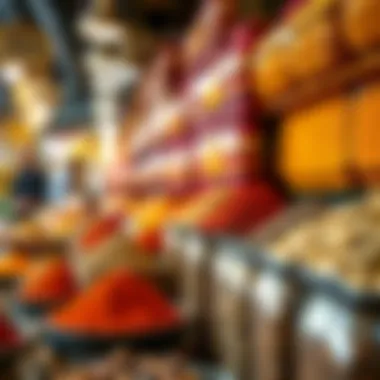
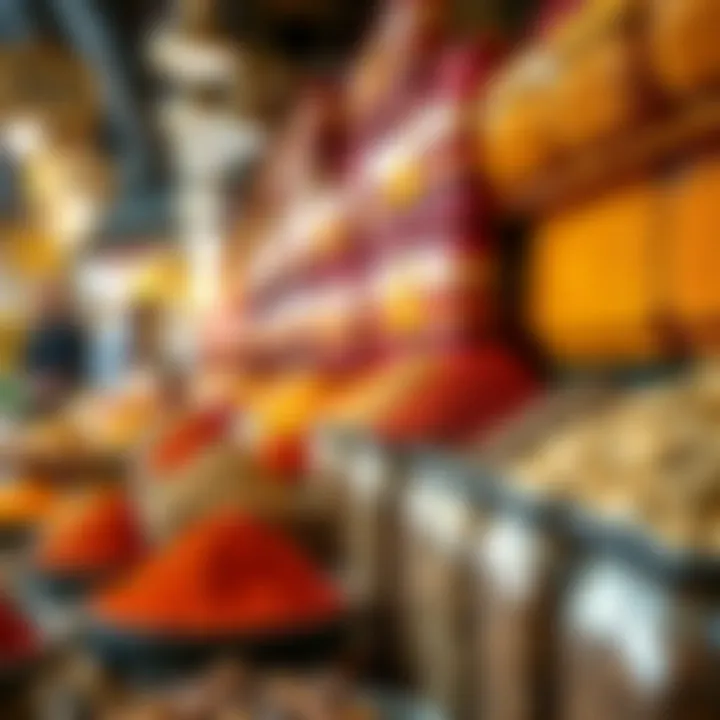
Intro
The Spice Souk in Dubai is more than just a marketplace; it is an intricate blend of aromas, tastes, and cultural nuances that make it a must-visit. Nestled in the old part of the city, this vibrant souk offers a complex tapestry of spices, herbs, and traditional goods that tell a story of trade and heritage. As you plan your visit, understanding the operational hours and key insights can elevate your experience, allowing you to soak in the rich atmosphere without feeling rushed.
This article serves to illuminate the logistical aspects of visiting the Spice Souk—from the best times to go, to the diverse offerings that await you. Given its multifaceted nature, having a firm grounding in the historical context of the souk can also be beneficial, as it reflects Dubai's journey from a modest fishing village to a global hub for commerce.
In the ensuing sections, we will cover not only the operating hours of the souk, but delve into its offerings, and the surrounding areas that enhance its charm. Understanding these elements can aid you in capturing the true essence of this bustling marketplace, ensuring a fulfilling and immersive cultural experience.
Let's get into the heart of the matter—how to make the most of your visit.
Preface to the Spice Souk
The Spice Souk is one of Dubai’s most colorful and fragrant destinations, steeped in a rich tapestry of culture and history. It serves as a vibrant market that goes beyond just trading spices; it reflects the very soul of the city’s heritage and its evolution as a global crossroads. Understanding the Spice Souk is crucial, as it not only offers insights into Dubai's past but also provides an immersive experience for visitors—whether they are tourists or locals.
The significance of the Spice Souk can be underscored by its harmonious blend of history and modern commerce. It provides a venue where old-world charm meets contemporary shopping practices. As you navigate through the narrow alleyways filled with spices, dried fruits, and exotic herbs, the atmosphere resonates with the sounds and scents of its long-standing trading tradition.
A visit to the Spice Souk is much like stepping into a time machine. One can't help but marvel at the enduring artisanal practices passed down through generations. This marketplace stands as a testament to the UAE's commitment to preserving its cultural identity in an ever-globalizing world.
Historical Significance
The origins of the Spice Souk can be traced back to before the discovery of oil in the region. In those days, Dubai served as a vital trade port connecting the East and the West, where merchants exchanged goods like spices, textiles, and precious metals. The souk has been pivotal in establishing Dubai as a key commercial hub in the Arabian Gulf. It is said that spices, such as saffron and cardamom, were the currency of trade during those times, adding immense value to the goods exchanged.
Throughout the years, the Spice Souk has not only witnessed the ebb and flow of economic change but has also preserved traditional Emirati culture. Vendors still employ time-honored practices in their selling techniques, often utilizing colorful burlap sacks to display their products, evoking a sense of authenticity that modern shopping malls fail to capture.
Cultural Impact on Tourism
Tourism is the lifeblood of Dubai’s economy, and the Spice Souk plays a critical role in attracting visitors from all walks of life. Travelers come not just for the unique culinary experiences, but also to absorb the local culture and traditions that the souk represents. The sensory overload of aromas and vibrant colors captivates tourists and encourages deeper engagement with Emirati lifestyle and hospitality.
The souk also offers an educational experience, allowing visitors to understand more about the spices and their uses in traditional Emirati cuisine, as well as in Arabic medicine and rituals. By engaging with local vendors, tourists forge connections with the Emirati community, fostering a balance between cultural preservation and modernization.
In essence, the Spice Souk serves not merely as a shopping destination but as a crucial cultural touchstone that enhances Dubai's tourism appeal. It encourages both curiosity and appreciation for the cultural layers that define the Emirates.
"A trip to the Spice Souk is an invitation to explore the flavors and stories that have shaped Dubai’s culinary landscape."
Overview of the Spice Souk
In the vast urban landscape of Dubai, the Spice Souk emerges as a vibrant tapestry of culture and commerce. This market is a sensory feast, offering visitors an astonishing variety of spices, herbs, and traditional ingredients that tell the story of Dubai's rich trading past. Understanding the Spice Souk goes beyond mere exploration of its stalls; it involves immersing oneself in its historical significance, cultural impact, and the unique sensory experiences it offers.
Location and Accessibility
Nestled along the Dubai Creek, the Spice Souk holds a strategic position that facilitates easy access for tourists and locals alike. It occupies a bustling area known for its proximity to other major attractions like the Gold Souk and the Dubai Museum. The souk is accessible via various modes of transportation, including:


- Metro: Al Ras station on the green line is just a short walk away.
- Water taxi: Arriving by boat adds an authentic touch to the experience.
- Buses: Several routes serve the area, making public transport a practical option.
For those coming by car, limited parking is available nearby, but it’s wise to arrive early to avoid the crowded streets.
Architectural Features
The architectural charm of the Spice Souk is noteworthy. Its narrow, winding alleyways are shrouded in a traditional Arabic design, characterized by wooden beams and beautiful arched doorways. The classic market structure provides a glimpse into the past while accommodating the present hustle and bustle. Key features include:
- Covered walkways: Shelter shoppers from the sun, creating a unique ambiance.
- Arabic-style architecture: Intricate designs that reflect the region's cultural heritage.
- Bustling vendor stalls: Each stall brimming with colorful displays of spices, bringing life and energy to the souk.
Walking through its alleys, you’re likely to be enveloped by rich scents—cumin, saffron, and cardamom dance in the air. The sight of local vendors displaying their wares with pride invites a deeper appreciation for the craftsmanship and knowledge handed down through generations.
"The Spice Souk is not just a market; it’s a gateway to the aromatic world of Middle Eastern cuisine, where every corner holds a new surprise."
In summary, understanding the Spice Souk provides insight into not just a marketplace but a cultural exchange fostering connections among people. Its location and accessibility enhance the experience for visitors, while the architectural features paint a picture of Dubai’s historical essence. Anyone venturing to this souk must appreciate its layered narrative, making it a must-visit destination for both cultural and culinary enthusiasts.
Opening Hours of the Spice Souk
The operational hours of the Spice Souk in Dubai play a pivotal role in shaping the visitor experience. Timing is an essential factor; it can dramatically influence how one interacts with the bustling marketplace and the variety of offerings available. Knowing when to visit allows travelers to maximize their time spent exploring the intricate array of spices, herbs, and unique items that encapsulate the local culture.
Understanding these hours is not just about when the souk opens and closes; it’s about strategizing the visit to match personal preferences and expectations. For instance, visiting during less crowded hours could lead to more personalized interactions with vendors and a more immersive shopping experience without the hustle.
Typical Weekday Hours
On a regular weekday, the Spice Souk typically opens its doors around 10:00 AM and remains vibrant until 10:00 PM. Visitors often notice a gradual increase in foot traffic as lunchtime approaches, with many local residents stopping by for a quick pick-up of spices for their cooking needs.
During the early hours, the souk is rather calm, which is perhaps the best time to engage with the vendors. The merchants share stories about their products, often passionate about the spices they're selling. Here’s a quick rundown of the typical weekday experience:
- Morning (10:00 AM - 12:00 PM): Peaceful pace; ideal for discovering uncommon spices.
- Afternoon (12:00 PM - 5:00 PM): Slightly busier; a blend of tourists and locals in search of the best ingredients.
- Evening (5:00 PM - 10:00 PM): Peak hours, vibrant atmosphere; perfect for those looking to experience the souk's lively ambience.
Weekend Operations
The weekends see a shift in the souk’s dynamics, as it becomes a hotspot for both tourists and locals. Typically, the Spice Souk extends its hours slightly during weekends, often opening from 10:00 AM and staying bustling till midnight on Friday and Saturday. This additional time allows for extended shopping hours and more opportunities to browse the various stalls without having to rush.
Many visitors choose to come during the evening to enjoy the cooler climate and the energy of the souk transformed by the night lights. Visitors can anticipate a vibrant social atmosphere, with many vendors showcasing a broader selection of goods to accommodate the influx of shoppers. Here’s a quick highlight of weekend operations:
- Friday & Saturday (10:00 AM - 12:00 AM): Increased foot traffic, festive mood, and lively vendor interactions.
- Sunday (10:00 AM - 10:00 PM): Returns to a more typical weekday structure, but still features a healthy flow of visitors.
Holiday Hours and Special Events
During holidays and special events, the Spice Souk adjusts its schedule, sometimes extending hours significantly to cater to the demands of festive shopping. It is essential for visitors to check the local calendar as variations can occur based on Islamic holidays or local festivals. For instance, during Ramadan, the souk may open later in the day and stay open into the evening to accommodate shoppers before Iftar.
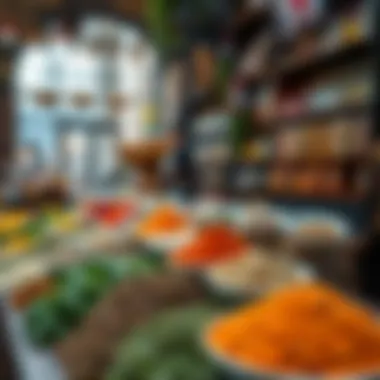
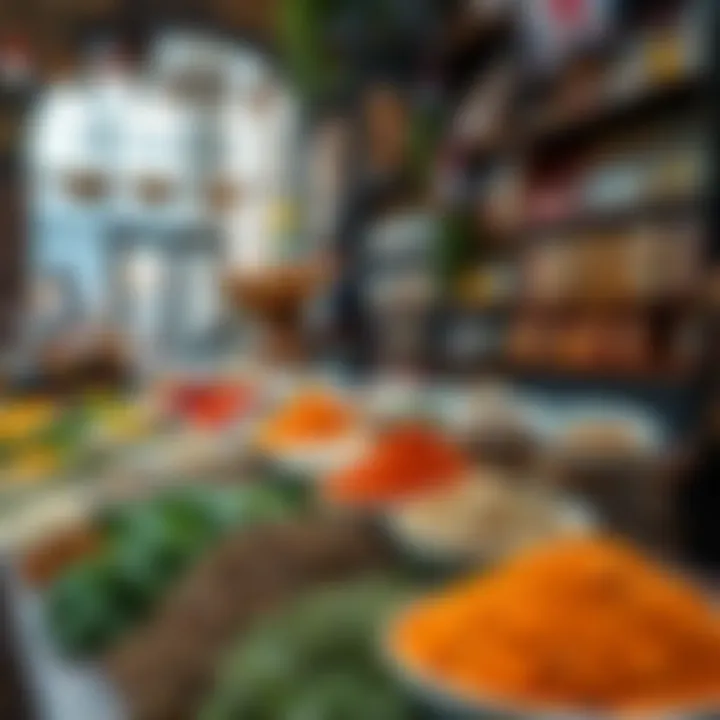
The souk also hosts unique events throughout the year, including spice-themed festivals that celebrate local cuisine and culture, making it an even more enticing place to visit during these times. Observing the nuances of holiday hours can unlock another layer of the souk's experience:
- Ramadan: Typically opens later in the morning, stays open through the night.
- Eid Celebrations: Often features stalls with special offers and events that highlight traditional foods and spices.
- Annual Food Festivals: Various events throughout the year with extended hours to celebrate local cuisine, offering visitors hands-on experiences and cooking demonstrations.
Understanding the opening hours of the Spice Souk is not merely about knowing when the doors are open; it’s about understanding how timings affect the shopping experience and the journey through this vibrant marketplace. Planned visits during the right hours not only ensure you make the most of your time but also allow you to delight in the rich tapestry of Dubai's trading traditions.
What to Expect at the Spice Souk
Visiting the Spice Souk is like stepping into a vibrant patchwork of aromas, colors, and textures. It's not just a marketplace; it’s a sensory feast that offers insights into Dubai's rich culture and trade history. Before setting foot in this bustling hub, understanding what to expect can significantly enrich your experience. From the variety of spices to the unexpected treasures, each corner of the souk tells its own story.
Varieties of Spices and Ingredients
When it comes to spices, the Spice Souk does not disappoint. You’ll find an impressive array of spices, ranging from the common to the exotic. Here, you can indulge your senses with vibrant saffron, fragrant cardamom, and earthy cumin, all available at competitive prices.
- Saffron: Often dubbed as "red gold," saffron is one of the most valuable spices in the world. In the souk, you'll see it stored in glass jars, letting its fiery hue tempt you. Vendors often share tales of its harvest, revealing why it's priced the way it is.
- Sumac: This lesser-known gem boasts a tart flavor and adds a unique kick to dishes. Many locals use it as a substitute for lemon in various recipes, and you'll find it disposed in piles, ready to be scooped.
- Za’atar: A staple in Middle Eastern cuisine, za’atar is a delightful blend of herbs. It’s often a favorite among tourists looking to recreate local dishes at home.
- Chili powders: The spice souk displays a rainbow of chili powders from mild to volcanic. Whether you are looking to spice up a simple meal or test the limits of your taste buds, there is something for every heat level.
Beyond spices, the souk presents a plethora of ingredients such as dried fruits, nuts, and unique cooking oils. Pushing past the spices, you’ll come across dried apricots, raisins, and nuts that are wonderfully packaged for gifting or snacking.
Other Products Available
While the spices steal the spotlight, the Spice Souk offers a more diverse collection of products that can enhance your visit. Vendors aren’t just selling spices; the array of goods available often surprises first-time visitors.
- Incense and Oud: The rich scents of traditional Arabic perfumes permeate the air. If you’re open to expanding your sensory experiences, you'll find a range of incense sticks and oud that echoes the region's aromatic heritage.
- Herbal Teas: From hibiscus to mint tea, the selection of herbal blends is eye-opening. These teas are not only refreshing but also a glimpse into the local tea-drinking culture.
- Traditional Utensils: You may also stumble upon beautifully crafted utensils, such as tagines or colorful plates used in traditional Middle Eastern cooking. They make unique souvenirs that carry stories from the souk back to your home.
- Artisan Crafts: Finally, don’t overlook the chance to pick up artisan crafts that showcase local artistry. Be it woven baskets or intricately designed carpets, these treasures bring a piece of Dubai’s cultural legacy back with you.
Every visit to the Spice Souk unveils something fresh, whether it’s a unique spice blend or a hand-crafted item. Don’t rush the experience; instead, take your time to engage with the products and the people selling them. One never knows what delightful surprises await just around the next corner.
Planning Your Visit
Visiting the Spice Souk in Dubai is not just a casual stroll; it’s an experience that requires some thought and planning. The market, saturated with vibrant colors and rich aromas, can be overwhelming if you dive in unprepared. To make the most out of your visit, you should think through a few crucial elements.
Firstly, understanding the timing of your visit is crucial. The Spice Souk can get crowded during peak hours, especially during weekends and holidays. This demand can make exploring the vibrant offerings challenging, as the crowds can be a bit much. Choosing to visit either early in the morning or during the late afternoon will provide a more comfortable experience. You’ll find the vendors more approachable, and there will be plenty of room to browse.
Next up, consider the season during which you plan to visit. Dubai experiences a significant influx of tourists during the cooler months, from October to April. If you prefer a quieter atmosphere, aim for the hotter summer months, but prepare for the sweltering heat as you traverse the outdoor sections of the souk.
Don’t overlook local holidays and events as well. During significant dates, the market can have unique offerings or, conversely, reduced hours of operation. This will require some homework on local festivities. Knowing what to expect culturally can enhance your experience, adding layers of depth to your exploration.
In summary, taking the time to plan your visit can transform your outing into an enriching experience. You’ll navigate the bustle of the souk and gain insights that many visitors may overlook.
Best Times to Visit
When exploring the Spice Souk, timing can make a world of difference. If you want a richer experience, I’d suggest you aim for a visit early in the morning right when the vendors open shop. The mornings often bring a fresh batch of spices, and the air is thick with exhilarating scents. As you wander through the narrow alleys, you’ll have the opportunity to speak with vendors who—likely/more often than not—are more willing to engage when it's not swarming with tourists.
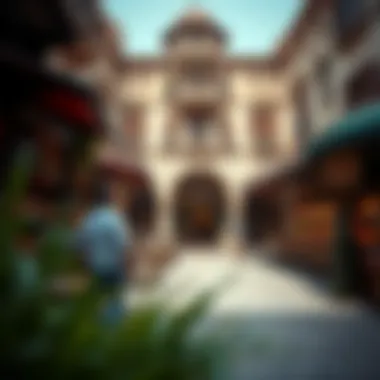

Visiting around lunchtime also has its perks; you can catch a glimpse of locals picking up ingredients for their daily meals, allowing you to see the souk in its authentic state. However, if you decide to visit during weekends or late afternoons, be prepared for larger crowds with holiday vibes. The hustle and bustle of shoppers gives a different sort of charm but can certainly complicate interactions with stall owners, as they’ll be keen on making sales over engaging conversations.
"The right timing can often translate to a more enriching journey, immersed in the stories each spice tells."
Navigating the Souk
Navigating the Spice Souk is akin to stepping into a sensory labyrinth. With numerous stalls lined up, each offering an array of spices, herbs, and other traditional items, it can feel overwhelming. Familiarizing yourself with a few guiding principles can streamline your experience and enhance your adventure.
Firstly, keep a map handy. While many navigate based on memory or intuition, having a map can help avoid unnecessary wandering, especially for first-time visitors. Some maps also indicate stalls known for specific items, helping you head straight for what piques your interest.
When you’re at the souk, be sure to use your senses wisely. Stop to savor the smells; each turn will introduce you to new scents that sweep you off your feet. If you have specific spices in mind, don’t hesitate to ask the vendors about them. They are often a wealth of knowledge and can provide background info, which enhances your shopping experience.
Lastly, embrace the art of walking slowly. Give yourself permission to meander. This isn’t just about buying; it’s about immersing yourself in the culture. The winding alleys have their own stories, and the more you appreciate your surroundings, the richer your experience will be. You never know when a casual chat with a vendor might lead to a remarkable insight into the world of spices.
In essence, being mindful of how you navigate the spice-laden aisles will deepen your appreciation, turning your visit into more than just purchasing items, but into a genuine exploration of culture and tradition.
Tips for an Enhanced Experience
Visiting the Spice Souk can be a vivid encounter, bursting with flavors, colors, and scents that swirl in the air. To make the most of your trip, a little preparation can go a long way. Here you'll find insights that enhance your experience, helping you navigate this vibrant marketplace with ease and enjoyment.
Engaging with Vendors
Engagement with vendors is an experience in itself. These merchants are not just selling products; they often share stories that breathe life into the spices and handmade goods they offer. Here are a few tips on how to approach this interaction effectively:
- Start with a Smile: A friendly demeanor opens doors. Vendors appreciate warmth and a genuine interest in their goods.
- Ask Questions: Inquire about the origin of spices, their culinary uses, or even personal recommendations. This shows you value their expertise.
- Listen Actively: Pay attention to their responses. Vendors often share insights that can enhance your cooking or offer new taste ideas.
- Show Respect: Recognize that some vendors may have a traditional method of selling. Respecting their way fosters goodwill and may yield better interactions.
This way, you're not just a shopper but a part of a rich cultural tapestry.
Bargaining Techniques
Bargaining is an expected skill in the Spice Souk. It’s not merely about getting the price down; it’s more about the dance between buyer and seller. If you're new to this, here are some practical techniques to help you along:
- Know Your Market: Before engaging, have a basic idea of what a reasonable price might be for the items you want.
- Start Low: Offer a price lower than what you’re willing to pay. This gives you room to negotiate upwards while keeping the vendor engaged.
- Be Prepared to Walk Away: Sometimes, indicating that you might leave can spur a vendor to offer a better deal.
- Stay Cool: Keep a relaxed and friendly attitude. This interaction is not a battle; it's a friendly negotiation.
- Combine Purchases: If you plan to buy multiple items, mention this. Vendors are often willing to provide a discount for bulk buys.
In summary, each shopping experience at the Spice Souk can be spruced up through effective engagement and strategic bargaining. Such actions can lead not only to savings but also to rich experiences, learning about the local culture and its flavors.
End
The conclusion of this article holds substantial weight as it encapsulates the essence of what the Spice Souk represents to both visitors and avid local enthusiasts. This historic market is not merely a place for purchasing spices but a vibrant cultural hub that embodies the pulse of Dubai’s rich heritage and ongoing evolution.
Recap of Key Points
In summarizing the main aspects discussed, we first examined the historical context of the Spice Souk, showcasing its roots and significance in the commercial landscape of the region. The article noted the operating hours, guiding potential visitors on the best times to explore, be it during relaxed weeknights or the busier weekends. We also highlighted the diverse array of products, extending beyond spices alone to include a variety of herbs, teas, and traditional Emirati goods. From there, practical tips for navigating the Souk, including effective bargaining techniques and nurturing vendor relationships, formed a crucial part of the experience. All these elements coalesce into a holistic approach to visiting one of Dubai’s most iconic attractions.
Future of the Spice Souk
Looking ahead, the future of the Spice Souk appears promising. As Dubai continues to evolve as a global metropolis, the Souk is likely to evolve too, maintaining its traditional roots while embracing modernity. Future initiatives may focus on enhancing the shopping experience through technology—think mobile apps or guided tours that offer insights via augmented reality. Conservation of the local culture is also likely to be prioritized. As more tourists flock to the area, there’s an opportunity for the Spice Souk to promote local artisans and organic products, thus ensuring sustainability.
Ultimately, the Spice Souk isn’t just part of Dubai’s history; it’s a living, breathing entity that will adapt to changes while holding onto its intrinsic allure. Understanding the Spice Souk is instrumental for anyone looking to immerse themselves in the vibrant tapestry of Dubai's culture, offering insights that enrich the experience and connect visitors with the heart of this extraordinary city.















